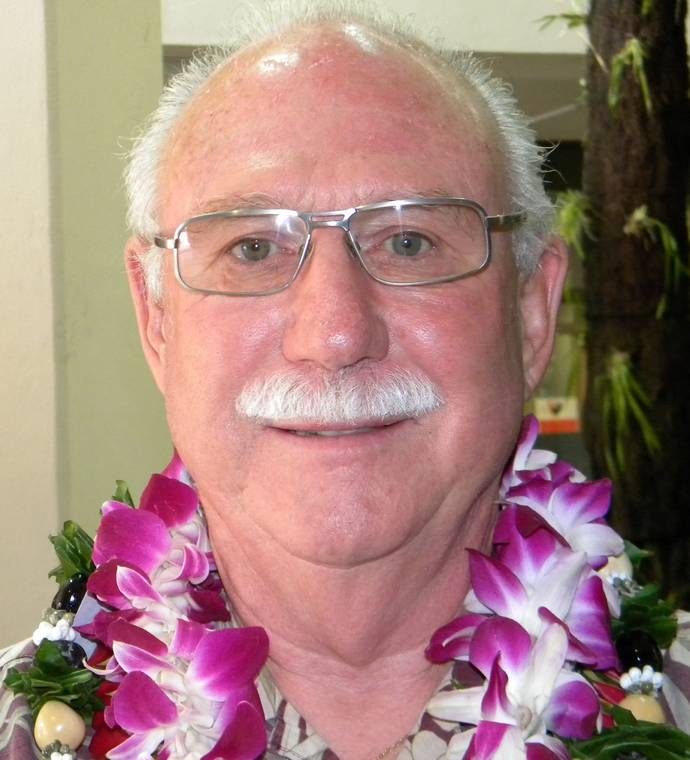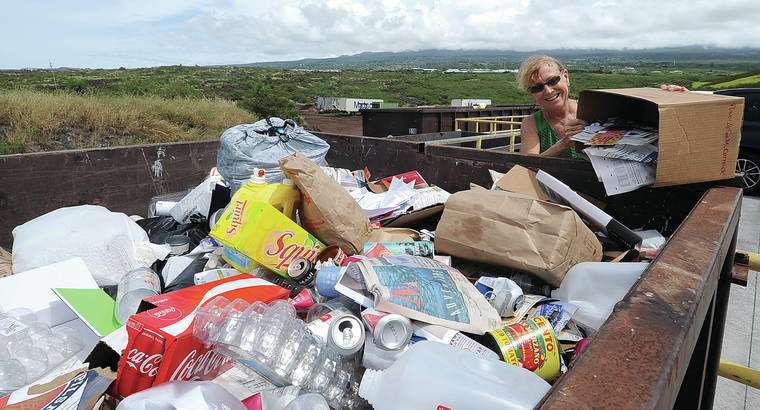KAILUA-KONA — Thousands of tons of recyclables once diverted from the waste stream will enter the Big Island’s landfills each year under changes implemented last week to Hawaii County’s recycling program.
With only corrugated cardboard, paper (Kraft) shopping bags and non-HI-5 glass products being accepted at county transfer stations as of Oct. 16, items such as office paper, newspaper and all plastics are headed farther downstream and into the landfill.
That’s expected to increase tonnage to landfills by approximately 3,100 tons annually, or about 1%-1.5%, according to information shared during the county Environmental Management Commission’s monthly meeting Wednesday at the West Hawaii Civic Center. Department of Environmental Management Director Bill Kucharski will present similar information during a County Council committee meeting Nov. 5 meeting in Hilo.
In 2018, nearly 224,200 tons were landfilled in Hilo and Puuanahulu after more than 58,800 tons — about 20.8% — of waste was diverted, including 37,915 tons of green waste and nearly 21,000 tons of recyclables. The Hilo landfill is expected to close in November, meaning all the island’s waste will be taken to the West Hawaii Sanitary Landfill.
Kucharski told the commission Wednesday that the changes were necessary in order to keep parts of the recycling program going after the contractor hired to handle recycling, Business Services Hawaii, notified the county it couldn’t afford to continue its $1.1 million annual contract at the current rate.
“This is something that snuck up on us,” Kucharski said. “We were not prepared for this, and we had no real indication from our contractor that they wanted to pull the plug.”
The company cited the loss of markets for the recycled materials, particularly in China and Southeast Asia. Just this week, America’s largest trash hauler, Waste Management Inc., announced it is no longer shipping plastics to countries outside North America because of a lack of market, according to various news outlets.
Business Services Hawaii advised the county about a week or two before its contract ran out Oct. 1 that it wanted to terminate the multi-year agreement, first awarded in 2016, and not execute the option to renew, Kucharski said. The contract was issued with the option for four one-year renewals.
“The contractor came in and said, ‘Look, I can’t do this, I want to terminate my contract, I’m not going to renew. We’re finished, there’s no market, I’m losing money, I can’t do this, I’m stopping it,’” Kucharski relayed to the seven commissioners present.
Additional discussions resulted in an agreement to continue parts of the recycling program, but with fewer items accepted via the two-bin recycling program, said Kucharski. The supplemental contract was executed with the company through Oct. 1, 2020.
Along with the downsizing of the program is a reduction in the value of the contract between the county and Business Services Hawaii. Under the current contract, the county will pay $133-$266 per ton, down from $159-$292 per ton.
“I think we saved $300,000 to $400,000,” Kucharski said.
The cost of recycling the materials is about 50% more than the cost of landfilling, which is about $110 per ton, he said.
Looking forward, Kucharski said the county is moving to execute a new contract upon expiration of the agreement with Business Services Hawaii next fall. A request for information will likely go out to see what services potential vendors can provide the county in addressing its waste stream.
In the interim, the department is reinforcing the three R’s — reduce, reuse and recycle — and educational programs aimed at minimizing the waste stream.
“But until that time, there’s not that much we can do,” Kucharski said. “We can handle these things responsibly and make sure they get into some level of control, even if that control is disposing in the landfill. Right now, that is basically our only option.
“The sooner we can come in and take a look at alternatives, the better we’re going to be.”
Kucharski said he’d like to see about 80% of what is going into landfills be recycled.
“We really need to take a look and we need to do whatever we’re doing better,” he said. “We need to take a really close look at it.”
A discussion about converting waste to energy is also forthcoming at the council, with South Kohala Councilman Tim Richard’s resolution urging the development of a plan for a waste stream reduction technology for renewable and alternative energy generation.
Email Chelsea Jensen at cjensen@westhawaiitoday.com.


